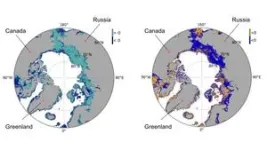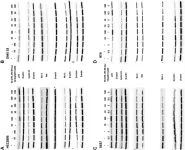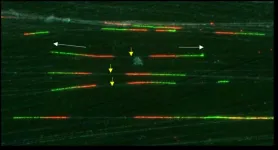(Press-News.org) March 4, 2024, Mountain View, CA – The James Webb Space Telescope (JWST) is helping scientists uncover how planets form by advancing understanding of their birthplaces and the circumstellar disks surrounding young stars, in a paper published in the Astronomical Journal, a team of scientists led by Naman Bajaj of the University of Arizona and including Dr. Uma Gorti at the SETI Institute, image for the first time, winds from an old planet-forming disk (still very young relative to the Sun) which is actively dispersing its gas content. The disk has been imaged before, winds from old disks haven’t. Knowing when the gas disperses is important as it constrains the time left for nascent planets to consume the gas from their surroundings.
At the heart of this discovery is the observation of TCha, a young star (relative to the Sun) enveloped by an eroding disk notable for its vast dust gap, approximately 30 astronomical units in radius. For the first time, astronomers have imaged the dispersing gas (aka winds) using the four lines of the noble gases neon (Ne) and argon (Ar), one of which is the first detection in a planet-forming disk. The images of [Ne II] show that the wind is coming from an extended region of the disk. The team, who are all members of a JWST program led by Ilaria Pascucci (U Arizona), is also interested in knowing how this process takes place so they can better understand the history and impact on our solar system.
“These winds could be driven either by high-energy stellar photons (the star's light) or by the magnetic field that weaves the planet-forming disk,” said Naman.
Uma Gorti from the SETI Institute has been conducting research on disk dispersal for decades, and with her colleague predicted the strong Argon emission that JWST has now detected. She is “excited to finally be able to disentangle the physical conditions in the wind to understand how they launch.”
Planetary systems like our Solar System seem to contain more rocky objects than gas-rich ones. Around our Sun, these include the inner planets, the asteroid belt and the Kuiper belt. But scientists have known for a long time that planet-forming disks start with 100 times more mass in gas than in solids, which leads to a pressing question: when and how does most of the gas leave the disk/system?
During the very early stages of planetary system formation, planets coalesce in a spinning disk of gas and tiny dust around the young star. These particles clump together, building up into bigger and bigger chunks called planetesimals. Over time, these planetesimals collide and stick together, eventually forming planets. The type, size, and location of planets that form depend on the amount of material available and how long it remains in the disk. So, the outcome of planet formation depends on the disk's evolution and dispersal.
The same group, in another paper led by Dr. Andrew Sellek of Leiden Observatory, performed simulations of the dispersal driven by stellar photons to differentiate between the two. They compare these simulations to the actual observations and find dispersal by high-energy stellar photons can explain the observations and hence cannot be excluded as a possibility. Andrew described how "the simultaneous measurement of all four lines by JWST proved crucial to pinning down the properties of the wind and helped us to demonstrate that significant amounts of gas are being dispersed." To put it into context, the researchers calculate that the mass dispersing every year is equivalent to that of the moon! A companion paper, currently under review by the Astronomical Journal, will detail these results.
The [Ne II] line was first discovered towards several planet-forming disks in 2007 with the Spitzer Space Telescope and was soon identified as a tracer of winds by Project lead Prof. Pascucci at the University of Arizona; this transformed research efforts focused on understanding disk gas dispersal. The discovery of spatially resolved [Ne II] and the first detection of [Ar III] using the JWST could become the next step toward transforming our understanding of this process.
“We first used neon to study planet-forming discs more than a decade ago, testing our computational simulations against data from Spitzer, and new observations we obtained with the ESO VLT,” said Professor Richard Alexander from the University of Leicester School of Physics and Astronomy. We learned a lot, but those observations didn’t allow us to measure how much mass the discs were losing. The new JWST data are spectacular, and being able to resolve disc winds in images is something I never thought would be possible. With more observations like this still to come, JWST will enable us to understand young planetary systems as never before.”
In addition, the group has also discovered that the inner disk of T Cha is evolving on very short timescales of decades; they find that T Cha’s JWST spectrum differs from the earlier Spitzer spectrum. According to Chengyan Xie of the University of Arizona, the lead author of this in-progress work, this mismatch could be explained by a small, asymmetric inner disk that has lost part of its mass in only ~17 years. Along with the other studies, this also hints that the disk of T Cha is at the end of its evolution. Chengyan adds, "We might be able to witness the dispersal of all the dust mass in T Cha's inner disk within our lifetime!"
The implications of these findings offer new insights into the complex interactions that lead to the dispersal of the gas and dust critical for planet formation. By understanding the mechanisms behind disk dispersal, scientists can better predict the timelines and environments conducive to the birth of planets. The team's work demonstrates the power of JWST and sets a new path forward in exploring planet formation dynamics and the evolution of circumstellar disks.
The data used in this work were acquired with the JWST/MIRI instrument through the General Observers Cycle 1 program PID 2260 (PI: I. Pascucci). The research team includes Naman Bajaj (graduate student), Prof. Ilaria Pascucci, Dr. Uma Gorti, Prof. Richard Alexander, Dr. Andrew Sellek, Dr. Jane Morrison, Prof. Andras Gaspar, Prof. Cathie Clarke, Chengyan Xie (graduate student), Dr. Giulia Ballabio, and Dingshan Deng (graduate student).
For more information and to stay updated on this fascinating journey through space, follow the latest releases and discoveries as we explore the universe's wonders.
Read the paper in the Astronomical Journal here:
https://iopscience.iop.org/article/10.3847/1538-3881/ad22e1
About the SETI Institute
Founded in 1984, the SETI Institute is a non-profit, multi-disciplinary research and education organization whose mission is to lead humanity's quest to understand the origins and prevalence of life and intelligence in the universe and to share that knowledge with the world. Our research encompasses the physical and biological sciences and leverages expertise in data analytics, machine learning and advanced signal detection technologies. The SETI Institute is a distinguished research partner for industry, academia and government agencies, including NASA and NSF.
Contact information
Rebecca McDonald
Director of Communications
SETI Institute
rmcdonald@seti.org
END
JWST captures the end of planet formation
Researchers image for the first time, winds from an old planet-forming disk which is actively dispersing its gas content
2024-03-04
ELSE PRESS RELEASES FROM THIS DATE:
Good news—MS drugs taken while breastfeeding may not affect child development
2024-03-04
EMBARGOED FOR RELEASE UNTIL 4 P.M. ET, MONDAY, MARCH 4, 2024
MINNEAPOLIS – Certain medications for multiple sclerosis (MS) called monoclonal antibodies, taken while breastfeeding, may not affect the development of a child during the first three years of life, according to a preliminary study released today, March 4, 2024. The study will be presented at the American Academy of Neurology’s 76th Annual Meeting taking place April 13–18, 2024, in person in Denver and online. The study examined four monoclonal antibodies for MS: natalizumab, ocrelizumab, rituximab and ofatumumab.
MS is a disease in which the body’s immune system attacks ...
Programs intended to reduce health insurance premiums may make coverage less affordable for the middle class
2024-03-04
PITTSBURGH, March 4, 2024 — Reinsurance programs, which were created to help lower premiums and increase enrollment in the Affordable Care Act’s health insurance marketplaces, may have had the opposite effects for many potential marketplace enrollees, according to a study by health policy researchers at the University of Pittsburgh School of Public Health, Duke University and University of Minnesota.
The study, published today in Health Affairs, is the first to examine the effects of a post-American Rescue Plan Act ...
PrEP discontinuation in a US national cohort of sexual and gender minority populations, 2017–22
2024-03-04
In the U.S., sexual and gender minority populations are disproportionately affected by HIV. Pre-exposure prophylaxis (PrEP) is a key prevention method, but its effectiveness relies on consistent usage. While a significant body of research has addressed PreP initiation and adherence, far less attention has been paid to the reasons for and consequences of PrEP discontinuation.
A team of investigators conducted a four-year U.S. national cohort study exploring PrEP discontinuation among sexual and gender minority people who initiated PrEP. “Our cohort was entirely comprised of individuals ...
USC Study: Medicare Part D plans increased restrictions on drug coverage
2024-03-04
Medicare Part D plans significantly increased restrictions on prescription drugs, excluding more compounds from coverage or subjecting more of them to review before patients could access the treatments, according to a new study from USC researchers.
Among drugs not in Medicare “protected classes,” the share of drug compounds restricted or excluded by Part D plans surged from an average of 31.9% in 2011 to 44.4% in 2020, according to the study published in the March 2024 issue of Health Affairs. Brand-name-only compounds (those without a generic alternative) were especially limited, with more ...
Sacituzumab govitecan plus platinum-based chemotherapy in breast, bladder, and lung carcinomas
2024-03-04
“[...] these results support the rationale and potential for favorable clinical outcomes of combining SG therapy with platinum-based chemotherapeutics in solid tumors.”
BUFFALO, NY- March 4, 2024 – A new research paper was published in Oncotarget's Volume 15 on February 22, 2024, entitled, “Sacituzumab govitecan plus platinum-based chemotherapy mediates significant antitumor effects in triple-negative breast, urinary bladder, and small-cell lung carcinomas.”
Sacituzumab govitecan (SG) is an antibody-drug conjugate composed of an anti-Trop-2-directed antibody ...
Global study unveils "problematic" use of porn
2024-03-04
A major international study led by a Canadian psychologist sheds light on a hidden phenomenon: how problematic use of pornography is affecting people in different parts of the world, across various genders and sexual orientations.
Published in the journal Addiction, the research stands out because, among the 82,000 people in 42 countries studied, it looks at groups that were often overlooked in the past, including women and individuals who don't fit traditional gender categories.
In their findings, largely based on ...
Newly discovered protein prevents DNA triplication
2024-03-04
This is a natural 'anti-failure' mechanism in the DNA copying process, hitherto unknown.
The DNA molecule is copied each time a cell divides. If, instead of being copied once, the DNA is copied several times, i.e. tripled or even quadrupled, the likelihood of cancer increases..
The new discovered anti-failure system relies on a protein called RAD51 to prevent DNA that has already been copied from being copied again.
Every time a cell divides, its DNA is duplicated so that the two daughter cells have the same genetic material as their parent. This means that millions of times a day ...
Less ice in the arctic ocean has complex effects on marine ecosystems and ocean productivity
2024-03-04
Over the past 25 years, the amount of summer Arctic sea ice has diminished by more than 1 million square kilometers. As a result, vast areas of the Arctic Ocean are now, on average, ice free in summer. Scientists are closely monitoring how this impacts sunlight availability and marine ecosystems in the far north.
“Many questions arise when such large areas become ice-free and can receive sunlight. A prevailing paradigm suggests that the Arctic Ocean is rapidly becoming more productive as sunlight becomes ...
Antarctica’s coasts are becoming less icy
2024-03-04
EMBARGOED UNTIL MARCH 4, 2024 AT 3:00PM U.S EASTERN TIME
An increase in pockets of open water in Antarctica’s sea ice (polynyas) may mean coastal plants and animals could one day establish on the continent, University of Otago-led research suggests.
The research, published in the prestigious international journal Proceedings of the National Academy of Science, aimed at understanding where open water might allow coastal species to settle in the future.
Led by Research Fellow Dr Grant Duffy from Otago’s Department ...
New research shows migrating animals learn by experience
2024-03-04
THIS RELEASE IS EMBARGOED UNTIL MARCH 4, 2024, at 3:00 PM U.S. EASTERN TIME.
Research led by scientists from University of Wyoming and Max Planck Institute of Animal Behavior shows that migrating animals refine their behavior as they get older, suggesting that experiential learning is an important part of successful migration.
While genetics and social behavior are important factors shaping animal migrations, information gained through individual experience also appears to help shape migratory movements, says a research team led by Ellen Aikens. Aikens, ...
LAST 30 PRESS RELEASES:
Boosting the cell’s own cleanup
Movement matters: Light activity led to better survival in diabetes, heart, kidney disease
Method developed to identify best treatment combinations for glioblastoma based on unique cellular targets
Self-guided behavioral app helps children with epilepsy sleep earlier
Higher consumption of food preservatives is associated with an increased risk of type 2 diabetes
NTU Singapore-led team captures first-ever ‘twitch’ of the eye’s night-vision cells as they detect light, paving the way for earlier detection of blindness-causing diseases
Global aviation emissions could be halved through maximising efficiency gains, new study shows
Fewer layovers, better-connected airports, more firm growth
Exposure to natural light improves metabolic health
As we age, immune cells protect the spinal cord
New expert guidance urges caution before surgery for patients with treatment-resistant constipation
Solar hydrogen can now be produced efficiently without the scarce metal platinum
Sleeping in on weekends may help boost teens’ mental health
Study: Teens use cellphones for an hour a day at school
After more than two years of war, Palestinian children are hungry, denied education and “like the living dead”
The untold story of life with Prader-Willi syndrome - according to the siblings who live it
How the parasite that ‘gave up sex’ found more hosts – and why its victory won’t last
When is it time to jump? The boiling frog problem of AI use in physics education
Twitter data reveals partisan divide in understanding why pollen season's getting worse
AI is quick but risky for updating old software
Revolutionizing biosecurity: new multi-omics framework to transform invasive species management
From ancient herb to modern medicine: new review unveils the multi-targeted healing potential of Borago officinalis
Building a global scientific community: Biological Diversity Journal announces dual recruitment of Editorial Board and Youth Editorial Board members
Microbes that break down antibiotics help protect ecosystems under drug pollution
Smart biochar that remembers pollutants offers a new way to clean water and recycle biomass
Rice genes matter more than domestication in shaping plant microbiomes
Ticking time bomb: Some farmers report as many as 70 tick encounters over a 6-month period
Turning garden and crop waste into plastics
Scientists discover ‘platypus galaxies’ in the early universe
Seeing thyroid cancer in a new light: when AI meets label-free imaging in the operating room
[Press-News.org] JWST captures the end of planet formationResearchers image for the first time, winds from an old planet-forming disk which is actively dispersing its gas content







